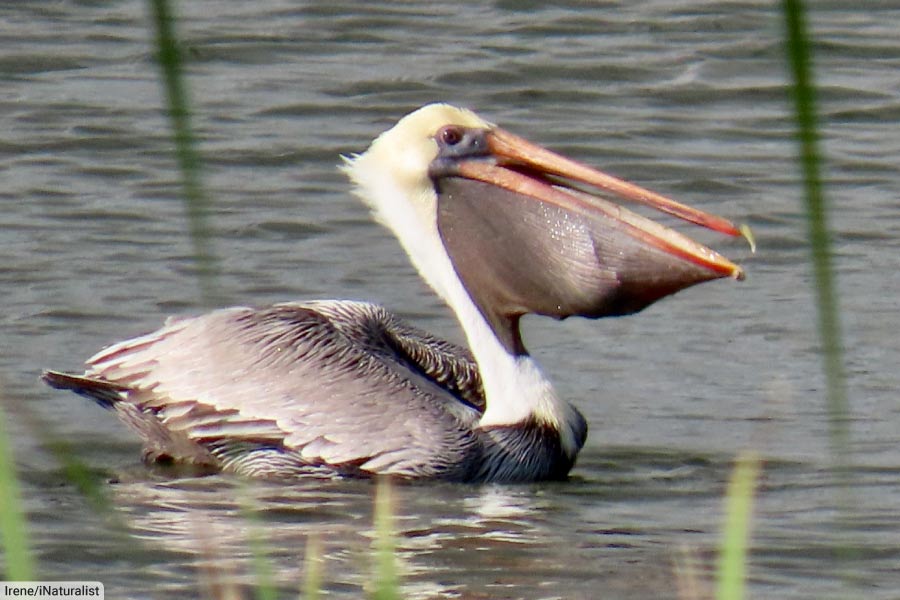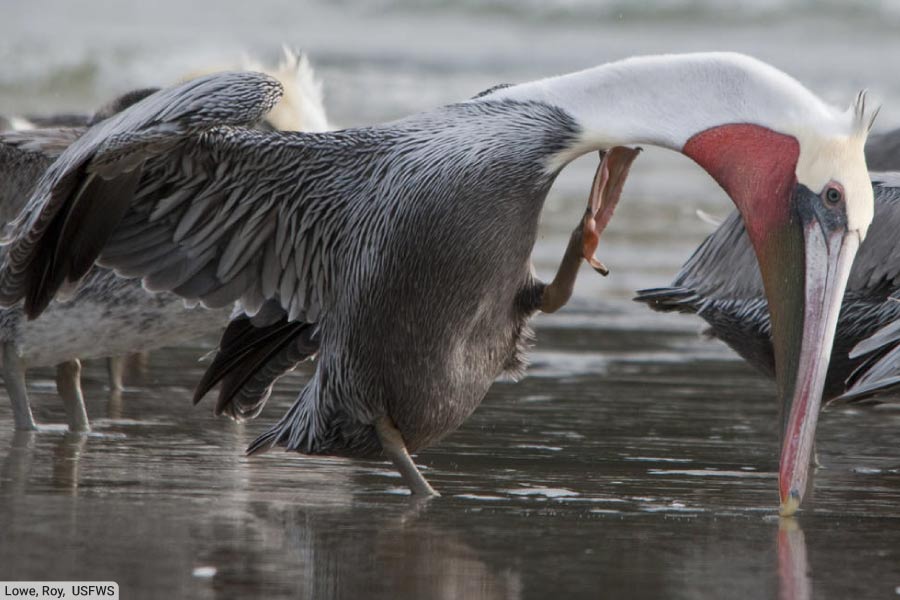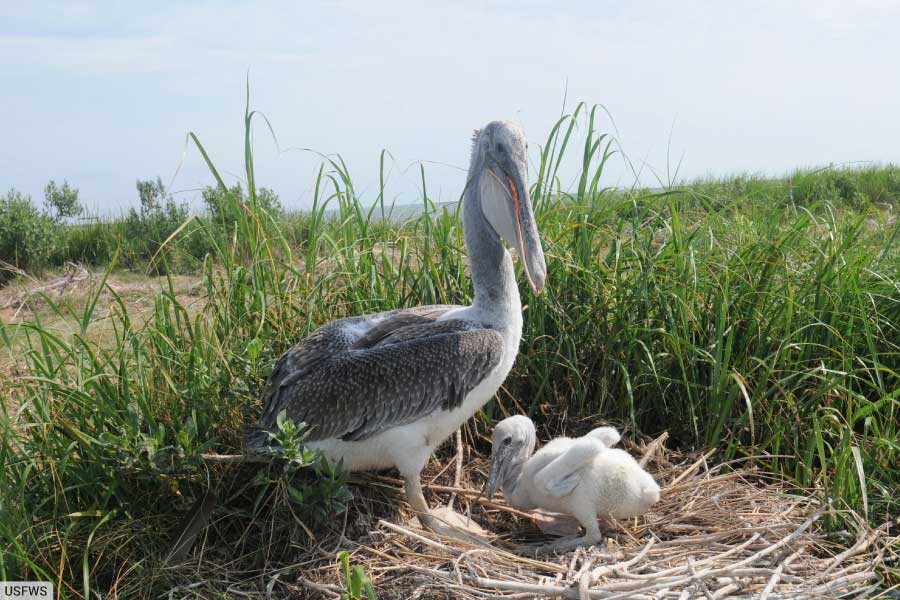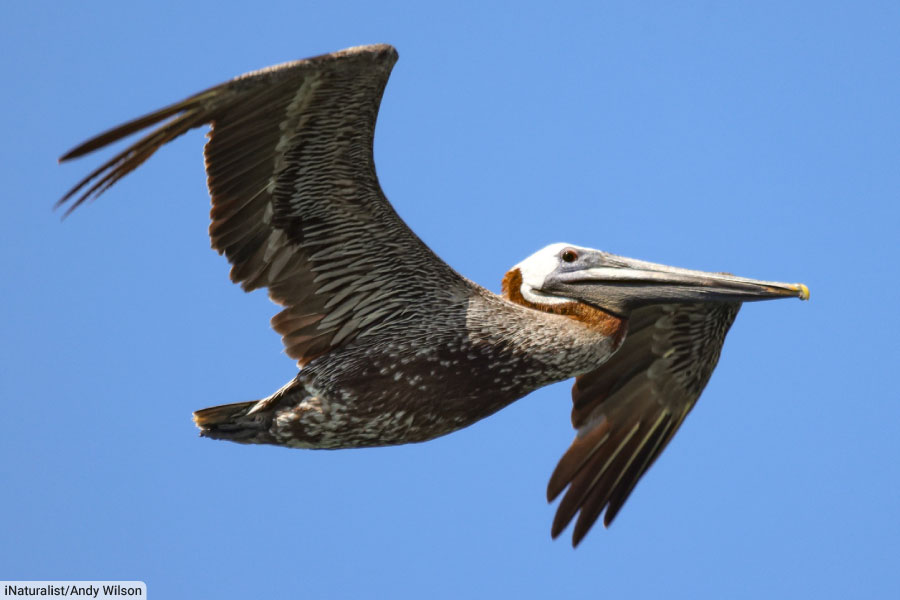The brown pelican, Pelecanus occidentalis, is a large water bird found on both the Atlantic and Pacific coasts of the Americas. Once an endangered species in the United States, the brown pelican made a successful recovery and is now a familiar sight in many coastal locations.
Page Index
- Brown Pelican Stats
- Brown Pelican Facts
- What is a Brown Pelican?
- Identification
- Location
- Habitat
- Diet
- Family And Related Species
- Life Cycle
- Lifespan
- Is the Brown Pelican Endangered?
- Discover More With Active Wild
Brown Pelican Stats

- Scientific Name: Pelecanus occidentalis
- Order: Pelecaniformes
- Family: Pelecanidae
- Weight: Approx. 2.75 to 5.5 kg (6 to 12 lb)
- Wingspan: Approx. 2.03 to 2.48 meters (6.7 to 8.2 feet)
- Where found: Coastal areas of the Americas, primarily from North America's Atlantic and Gulf coasts to the Amazon River in South America.
- IUCN conservation status: Least Concern
Brown Pelican Facts
- The brown pelican is the smallest of the eight living pelican species.
- The species is one of two pelicans found in North America (the other being the American white pelican, which can be recognized by its all-white coat).
- The brown pelican is a piscivore (fish-eater).
- The species dives from heights of up to 20m (66 ft.) into the water to catch its prey, and is the only North American pelican to catch food in this manner.
- Air sacs under the skin cushion the bird’s body from the impact of hitting the water. The air sacs also provide buoyancy that allows the bird to return to the surface.
- The brown pelican is a strong swimmer, capable of reaching depths of up to 30 ft / 9.14 m.
What is a Brown Pelican?
The brown pelican is a coastal water bird belonging to the pelican family, Pelecanidae. Like other pelicans, it is a large bird with a long bill and expanding throat pouch.
A familiar sight in coastal locations in North and South America, the brown pelican is often seen gliding silently over the ocean, and plunge-diving for fish with an elegance that belies its size. (The brown pelican is the only North American pelican species that dives from the air into the water.)
Once endangered in the United States (due mainly to the use of the pesticide DDT, which affected the bird’s eggs) the brown pelican has since bounced back and was removed from the country’s Endangered Species Act in 2009.
Brown Pelican Identification

- Large size (larger than any gull, but slightly smaller than the American white pelican)
- Characteristic pelican features: large bill, expandable throat pouch, long neck
- Grey-brown plumage, yellow head
- Dives from height (unlike the American white pelican)
The brown pelican has an appearance typical of pelicans, with a long bill, large wingspan, and expansive “gular pouch” — a skin pouch located underneath the beak, used for catching and briefly storing fish before consumption.
Adult brown pelicans have predominantly grayish-brown body plumage with a yellow or creamy white head, the yellow being accentuated further during the breeding season.
The neck is white outside of the breeding season, when it becomes a darker, maroon-brown hue.
Plumage coloration, size and throat-pouch coloration all vary between the species’ five recognized subspecies.

Despite being the smallest of the eight living pelicans, the brown pelican is nonetheless a large bird, with a wingspan ranging between 2.03 to 2.48 meters (6.7 to 8.2 feet) – larger than that of any gull.
The brown pelican's wings are broad and robust, lending it the strength for long flights and its characteristic soaring above coastal waters. Its wingbeats are slow and powerful.
Male and female brown pelicans are similar in appearance, with males being slightly larger than females.
Where are Brown Pelicans Found?
The brown pelican is primarily found in the coastal regions of the Americas. Its distribution extends as follows:
- North America: Along the Atlantic, Pacific, and Gulf coasts of the United States. The species is particularly prevalent from Nova Scotia to the Venezuelan coast and from Southern California south to Brazil. Brown Pelicans are a common sight in places like Florida, Louisiana, and the Carolinas.
- Caribbean: The brown pelican is present in many Caribbean islands.
- Central America: The species spans the entirety of the Central American coast, from Mexico to Panama.
- South America: The brown pelican’s range extends along the Pacific coast, reaching as far south as northern Chile, and on the Atlantic coast down to Brazil, especially in the Amazon River delta.
Habitat
While Brown Pelicans are predominantly coastal birds, they are occasionally (but rarely) spotted in inland waters, especially after storms. They typically prefer saltwater and brackish habitats, including beaches, estuaries, bays, harbors, and lagoons. Unlike some other pelican species, they are rarely found far from saltwater environments.
Brown Pelican Diet
The brown pelican is primarily a piscivore (fish-eater). It has a preference for small fish, including menhaden, mullet, anchovies, herring, and sardines, and will consume other fish species based on regional availability.
The brown pelican also consumes crustaceans such as prawns. Amphibians and bird nestlings are also occasionally (but rarely) taken.
Brown Pelican Family And Related Species
The brown pelican is a member of the pelican family, Pelecanidae. All eight living pelicans are listed below:
- Great White Pelican (Dalmatian Pelican), Pelecanus onocrotalus, Found in southeastern Europe, Asia, and Africa, around swamps and shallow lakes.
- Dalmatian Pelican, Pelecanus crispus, Freshwater lakes, rivers, and deltas in southeastern Europe to India and China.
- American White Pelican, Pelecanus erythrorhynchos, Mainly in the interior of North America, migrating to the southern United States and Mexico in the winter.
- Brown Pelican, Pelecanus occidentalis, Coastal areas of the Americas, from North America's Atlantic and Gulf coasts to the Amazon River in South America.
- Peruvian Pelican, Pelecanus thagus, The Pacific coast of South America, primarily in Chile and Peru.
- Pink-backed Pelican, Pelecanus rufescens, Across sub-Saharan Africa, frequenting a variety of freshwater and saline habitats.
- Spot-billed Pelican (Grey Pelican), Pelecanus philippensis, Regions of southern Asia, from southern India to the Philippines.
- Australian Pelican, Pelecanus conspicillatus, Found throughout Australia, Papua New Guinea, and parts of Indonesia, primarily near coasts, large lakes, and other large bodies of open water.
The pelican family belongs to a larger group, the order Pelecaniformes, which is also home to herons, ibises, spoonbills, frigatebirds, gannets, boobies, cormorants, shags, the shoebill and the hamerkop – the latter two species being the pelicans’ closest relatives.
Brown Pelican Life Cycle

Brown Pelicans typically nest in colonies, either on the ground in places like sandy islands or in trees and shrubs. The nests are constructed from sticks, grass, and other vegetation.
Females typically lay 2 to 3 eggs, though sometimes clutch size may be as large as four eggs.
Both parents share the responsibility of incubating the eggs. They use their feet, which are well vascularized, to regulate the temperature of the eggs. The incubation period lasts about 28 to 30 days.
Brown pelican chicks are altricial, meaning they are born blind, naked, and dependent on their parents. The chicks are fed by regurgitation. Initially, the chicks obtain food by sticking their bills down the parent's throat.
Over the first few weeks, the chicks develop rapidly. They start to grow downy feathers and eventually, by the age of 5 to 6 weeks, become quite mobile and can leave the nest.
At about 9 to 12 weeks old, the young pelicans are ready to fledge. During this period, they continue to depend on their parents for food, but begin to explore their surroundings and practice flying and diving.
After fledging, the young Brown Pelicans still rely on their parents for several more weeks. They often gather in large groups with other juveniles.
Brown pelicans only acquire their full adult plumage at around 3 to 4 years old, and reach sexual maturity at around 3 to 5 years of age. Although the species does not mate for life, it forms a monogamous pair for a breeding season.
Lifespan
The lifespan of a brown pelican is 15 to 25 years.
Is the Brown Pelican Endangered?
The Brown Pelican is not endangered; the species is currently (as of Aug 2023) classified as "Least Concern" by the International Union for Conservation of Nature (IUCN).
Historically, the Brown Pelican faced severe population declines, primarily due to the effects of the pesticide DDT. The chemical interfered with calcium processing in birds, leading to thin eggshells that would break easily, thus affecting reproductive success. In response to these declines, the Brown Pelican was listed as endangered in the United States in 1970 under the Endangered Species Act (Wikipedia).
The U.S. banned DDT in 1972 and following significant conservation efforts, Brown Pelican populations began to recover. The species was removed from the U.S. Endangered Species list in 2009.
Discover More With Active Wild
You can find out more about birds on this page: Birds – The Ultimate Guide
Discover different types of birds on this page: Types of Birds
Visit our main animals page for links to animal information and a complete guide to the animal kingdom: Animals


